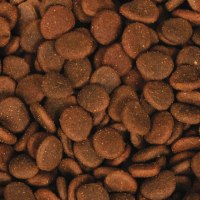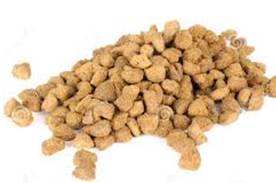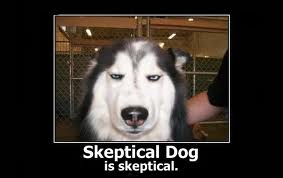Every once in a while, I read a paper that makes me scratch my head. Last week was just such a moment. The paper really needs no introduction. The title says it all: “Increasing volume of food by incorporating air reduces energy intake” [in dogs].
Let’s talk about obesity (again): If you read “Do you think I look fat in this collar?” you will remember that obesity is the most prevalent nutritional disorder in pet dogs today. Moreover, there is evidence that a substantial number of owners do not recognize overweight conditions in their dogs and even when they do, are unwilling or unable to comply with weight loss recommendations.
In their search to identify new approaches to weight control (preferably approaches that can be marketed into a new brand of dog food), some pet food companies have looked at the effects of diluting food calories. An example is increasing dietary fiber. This reduces the number of calories provided in a cup of food. Consuming foods that are high in non-fermentable fibers may also enhance feelings of satiety (fullness) in dogs, although the evidence for this effect is not conclusive. However, feeding high levels of dietary fiber causes increased defecation frequency and stool quantity, often producing voluminous poops that are loose and smelly, effects that most owners are not looking for in a dog food.
Recently, in their quest to find a canine version of the weight loss Holy Grail, researchers latched on to a nutrient that most of us would probably not even consider when thinking about keeping Muffin trim. (We would not consider it because it is actually not a nutrient).
The Study: A group of researchers at the Royal Canin Research Center, at the National College of Veterinary Medicine in France and at the University of Liverpool in the UK collaborated to study the effects of feeding a dry dog food formulated to contain more air (1). They wanted to determine if there was a satiety-producing effect of adding air to extruded kibbles, thereby increasing the volume that is fed whilst delivering the same number of calories. This is essentially a cheaper version of the “let’s add fiber to dog food to dilute its calories” approach.
To understand this concept, consider the density (weight/volume) of a cup of corn meal compared with the density of a cup of air-popped popcorn. Same food; more air in the latter than the former. As a result, the cup of popped corn will contain fewer calories and nutrients than the cup of ground corn meal. When we are talking about extruded dog food, this idea is quite easy to put into practice because varying extrusion conditions during processing can lead to different degrees of expansion in the end product. Highly expanded kibbles contain more air pockets, will feel lighter (because they are), and will provide fewer calories per cup than a food that has the same nutrient formulation but is less expanded. Compare the two examples below:
The food on the left is a very dense product and provides about 460 kcal/cup when fed to a dog. The food on the right is less dense (you can see the little air pockets in the kibbles), and provides about 320 kcal/cup when fed. (Note: Multiple factors, not only air, affect a food’s energy density. These include the food’s digestibility and fat content, among other attributes).
The Air-enhanced Food: The researchers created a test diet that was extruded to include a higher proportion of air than that which is typical. Simply expanding the kibbles to a greater degree and increasing its trapped air pockets resulted in a caloric density that was about half that of the control food. The control diet was a food that contained the same ingredients and nutrient profile, but less air. The researchers conducted three feeding trials:
- Experiment 1 measured the length of time that it took dogs to consume a meal that contained increasing proportions of the test diet while still providing the same number of calories. Therefore, because the test food contained less than half of the calories per cup than the control food, the amount of food that was fed more than doubled when the test diet was fed exclusively. Results: Not surprisingly, it took dogs longer to eat the larger meals of air-enhanced food than it took them to eat the smaller volume of food that they were given of the control diet. (In other words, it took the dogs longer to eat, um……more food). Although this sounds obvious, there is some evidence (in human subjects) that slowing down the rate of eating while consuming the same number of calories enhances satiety by increasing the release and effects of satiety-inducing and appetite-suppressing hormones.
- Experiment 2 fed the test food and the control food to a group of 10 adult Beagles and used a standard procedure used to measure satiety. This methodology involves offering dogs more food than they are expected to eat in sequential meals spaced one hour apart (kinda like “first breakfast and second breakfast” for Hobbit fans). Results: Adding air to food slightly enhanced feelings of satiety in dogs. This means that the dogs consumed a bit less food each day (and fewer calories) of the air-enhanced food when allowed to eat all that they desired than they did of the control food. This effect is similar to the expectation that consuming a high fiber food will lead to making one feel a bit more full and subsequently to consuming less food overall.
- Experiment 3 used the same protocol as Experiment 2 and compared the satiety-inducing effects of the test diet with a commercially available adult maintenance dog food. The commercial food provided more than 3 times the calories per cup as the test, air-enhanced food. Results: The results were similar to those of Experiment 2. Adding air (lots of it, by comparison) to a food moderately enhanced feelings of satiety in the dogs. I envision a group of over-stuffed Beagles, burping politely (and repeatedly….it is air after all), and saying “Really. No. I couldn’t eat another bite”.
The researchers concluded: “….results from the present study indicate that incorporating air into food provides a strategy to reduce energy [caloric] intake in dogs and, consequently could be a useful strategy for weight management in pets.” They also note that this study did not show whether or not dogs would reduce their intake of air-enhanced food to levels that would lead to weight loss nor did it measure effects for more than a few days. They assure us that such research is yet to come.
Draggin’ Out the Ol’ Box: Even if it can be shown that increasing the amount of air in a dog’s food enhances satiety, do we really need such a food? If one’s goals are to reduce a dog’s caloric intake and slow rate of eating, there are already effective approaches that owners can take. We can first select a high quality food (or home prepared diet) that is well-matched to our dog’s lifestyle and activity level. If a dog gains too much weight, we can reduce the amount that is fed or switch to a food that is still of high quality but is lower in fat (i.e. less energy dense without diluting calories). Increasing exercise through daily walks, engaging in a new dog training activity or sport, or teaching retrieve or “find it” games will all burn more calories and help increase a dog’s fitness level.
What about satiety? Is it true that feeding a larger volume of food or slowing the rate of eating will help our dogs to feel more satisfied? Perhaps. There is certainly some evidence to support this theory. However, while the hormonal changes associated with a slower rate of eating may enhance feelings of satiety, do we really need to inject air into our dog’s food to accomplish this? Many owners spread out their dog’s daily meal time by using a food delivery toy that their dog enjoys or feed using a “slow” bowl that is constructed to make the dog work a bit harder for his food. Feeding multiple small meals a day or floating dry food in warm water prior to feeding can be helpful to slow rate of eating as well.
Surely, we should not be expected to view injecting air into food as the new miracle weight loss approach for dogs. Are we really destined to see a new brand of dog food on the shelves selling under the marketing slogan of “Let Them Eat Air“?
Cited Study: Serisier S,Pizzagalli A, Leclerc L, Feugier A, Nguyen P, Biourge V, German AJ. Increasing volume of food by incorporating air reduces energy intake. Journal of Nutritional Science 2104; 3;e59:1-5.
Excerpted from: “Only Have Eyes for Your: Exploring Canine Research with the Science Dog” (2016).









I would like to know if introducing more air into the food increased the chances of bloat (in addition to just being a silly idea).
LikeLike
Hi Nicole – I agree and wondered about several potential health risks, the most dangerous of which is bloat. Even just the burping……I was only half-kidding with that comment.
LikeLiked by 1 person
“air we go again. Or air has never been so valuable.:-)
LikeLiked by 1 person
Thanks, This article is great. My dog is a little over weight so I just started to feed him a little less and exercise him a little more. The last thing I want to do is fill him with hot air.
LikeLiked by 1 person
I’d say the biggest benefit of adding air is one the experiments didn’t cover: the psychological effect on the owner.
Scenario: I want to be nice to my dogs. I think they feel sad when I cut back their portions because they’ve gotten too fat. Enter air-enhanced dogfood. Voila! I can still give them a full measuring cup but they get a third fewer calories! I don’t have to feel guilty. They are still getting the “same amount”.
Although it’s sneaky and in some ways deceitful, I’d think that for some people air enhancement is a better route to weight reduction than shifting to the low-fat, high fiber mixes sold for weight reduction. I’ve found that the weight reduction formulations tend to result in dull coats with my dogs. On my not-very-sophisticated understanding, I attribute this to cutting back too far on fat.
btw. I am guilty of using air foods in a minor way, and like the result. I found a cheap treat called “Pupcorn” in a local discount store. It is mostly corn (actually, mostly air), but only 3.1 calories per piece, and extremely crunchy. Each piece is sort-of dog-shaped and orange. My dogs regard it as a very high value treat, probably because of the crunch. I doubt they care about the shape or color.
LikeLike
This is exactly what I was thinking as I read the post. I hear so many people say, “Oh, I have to feed Fluffy more than *that*! He’ll starve / protest / hate me / etc!” when confronted with appropriate kibble amounts. People know that eat less, move more is the secret to weight loss (barring medical causes), but how many actually do it. Same with feeding toys and games: people are always shocked when I explain that my dogs don’t what kibble in a bowl looks like.
Further, as was explained at the start of the post, people don’t always like the effects weight loss foods. More frequent and voluminous stools, poor fur and skin condition, and other undesirable effects may result in owners discontinuing the use of current weight loss formulas.
Finally, there is some evidence that this approach (adding volume through increased air or water) does have a positive effect on human weight loss / maintenance efforts (Barbara Rolls, volumetrics research). It seems worthwhile to at least explore this option in the canine world.
LikeLike
This is a general comment about your blog, not just this post. It is my favorite blog. You manage to combine a subject of great interest, very good writing, and trustworthy science well applied. I wish there were more like you. My dogs (Collies) have always been trim and slim and they self-feed. Food is always available and they eat just about the amount it says they should on the package. They also get a few treats during the day — chicken strips and one Greenie a day. From talking to other dog owners I suspect this blessed life is a breed issue. I don’t know anyone who has a Beagle or Lab who could do this. Any thoughts, anyone?
LikeLike
Thanks so much for your kind words. I am so glad that you enjoy the blog and find it helpful! Your point about self-feeding is interesting and I agree that there appears to be very significant breed differences regarding dogs ability to maintain proper condition with self-feeding. We have a feeding lecture as part of our beginner training course at AutumnGold and we always ask students about their feeding practices. A relatively small number are able to self-feed their dogs, and when they do, these are often herding breeds (German Shepherd Dogs, Collies, BCs, etc.). They also tend to be dogs who live in single-dog homes (which is not the case for your dogs, of course). On the other hand, try this with a Lab or Golden or Beagle, and, well, we all know how that would work out! 🙂 I have not seen any research studies on breed differences in eating behaviors in dogs, but will definitely keep a look out for one, as it is an interesting topic! Thanks for posting – Linda
LikeLike
Sorry, my comment was unclear. When I said ‘Collies’, plural, I didn’t mean I have multiple dogs at once. I have had multiple Collies, but only one at a time. So your thought that free-feeding only works in single-dog homes could apply. However there is a Collie breeder here in KS, Cook’s Collies, who has all their puppies free-feeding and it seems to work. I would love to see some research on breed differences about this issue.
LikeLike
Thanks for clarifying, Cynthia. I will definitely do a search to find if there is anything available regarding breed differences, as it would make an interesting blog topic. On a completely difference topic, I just started following your blog, Timshala Gardens. I am a (very) amateur and novice gardener, and am getting more hooked every year. I look forward to reading your blog and learning from you! Linda
LikeLike
I’m glad you are enjoying my blog. Be very, very careful…gardening can be addictive. That’s how we all get started; just one little puff and a year later we’re buying by the carton. Starting with a strip of a garden about 10′ x 40′ I have now graduated to 6 ACRES! I believe the best kind of gardening combines science and art and I think that is why I was so pleased when I found you by reading your book “Beware the Straw Man…”. Because the same thing is true of both pet care and gardening. Love is not enough.
LikeLiked by 2 people
I think Jen Robinson has cracked it – this is about doting owners, not about dogs. The experiment that needs to be done is to test Jen’s hypothesis of the effect on owners who feed by looking at the food bowl, not at the dog.
This is not even new, “corn puffs” are expansion extruded human snacks that probably contain less metabolisable energy than it takes to detoxify the horrible flavours and colours they are coated with. They have the bulk density of styrofoam. Come to think of it, you can buy corn-based biodegradable packing chips, for nearly nothing per unit volume. Produce those in a spotty brown colour with a meaty flavour and owners can dilute the proper dog food themselves.
What worries me is which end the extra air is expelled from !
LikeLiked by 1 person
With regards to the whole satiated comments/notion/idea all throughout the research study… They’ve never met a dachshund, have they? If my doxie had his way, he’d be morbidly obese. I sincerely believe he either A.) simply doesn’t get full or B.) chooses to ignore the feeling of fullness in lieu of, well, more food and the “happiness” or “satisfaction” he gets from simply eating.
LikeLiked by 1 person
While it seems clear that overeating is somewhat related to breed and personality, the owner still (or should) controls the limit. The store I buy dog food at not only limits their stock to quality brands, but added a dog scale so you can check for weight changes and get advice if it increases. At home I got rid of my human scale, and use a dog scale for all of us (dogs plus the cat), to check and adjust monthly.
Even with measured food for meals, I’ve found people who have dificulty limiting treats. So I tell them to put the day’s treats in a bag or box in the morning, and stop feeding when it’s empty. That’s the only good approach I’ve found for that issue.
As for dog food with more air in it, I’ll just agree with your comments on it.
LikeLike
Hi Gerry – I love the idea of a pet store having a dog scale available! We added one to our training facility a few years ago and I use it to (almost obsessively…) keep careful track of my own dogs’ weights, but also have it available to all of our students. And, I completely agree that it is still the owner’s responsibility (I talk about this in the blog “Do you think I look fat in this collar”, as well). Nice tip for treat-giving too – thanks for sharing! Best wishes, Linda
LikeLike
Yes, I really loved your other blog and shared it around. That same store started giving out cheap measuring cups to leave with the dog food, to avoid people just guessing. My dog was down about five pounds, and 1/4 cup extra was all that was needed to bring him back up.
LikeLike
Hi, people love to feed their dogs, and sometimes we think that we are showing love when we give our dogs food. However dogs who are overweight are at risk of developing life stealing problems. If you use food to train your dog make sure to use a portion of their daily food rations and try not to over do it. Like the old saying goes, ” All things in moderation.Thanks
LikeLike
Reblogged this on Adventures at Run A Muck Ranch and commented:
What marketing gimick will they think of next?
LikeLiked by 1 person
Thanks for the Reblog, Run A Muck! (Love, love your blog, BTW!) Linda
LikeLike
Thank you!
LikeLike
I think it was a funny way to put it, but I CAN see that increasing the volume of a certain amount of food, could mean that owners feed a lot less food when they feel the necessity to fill their dog’s food bowl. Similar in a way to the advice for people to serve their means on smaller plates. 🙂
It would seem to me better though to add water to reduce calories per volume. Too many people do judge their dogs’ meals by volume and I have seen (relatives) feeding their little dogs far more per day than I would feed my large dogs, because they fill the too large anyway, feed bowl.
LikeLike
You can buy dogfood prepared by adding water. It’s called canned food. A few disadvantages. 1) Water is heavier than air; to get the same food value you end out with twice or three times as much weight; 2) Wet high-energy stuff attracts bacteria, fungi, insects, and other organisms, hence the need for a can; 3) dry food is — so I’ve heard — better for dental health.
LikeLike
Yes, I know. Or you can feed *real* food that hasn’t been dehydrated.
But I was meaning adding the water TO to dried food, before the dog gets to eat it!
LikeLike
Adding water increases the aroma (or so people say). Possibly much more so for dogs than us, given they have a working vomeronasal organ, and the VNO works best on moist things (tracker dogs work best when the morning dew is out). So I’d think moistening the kibble would increase the dog’s appetite. I have Labs, though, and they’ll bolt anything I feed them, in whatever quantity it’s given.
In Australia they sell a hard-tack like food for greyhounds. I wouldn’t want to give it to my Labs ’cause they don’t chew and I don’t like the idea of a 2″ square going down whole or in two pieces.
LikeLike
Actually, these are the biscuits I feed my dogs — but they are NOT a ‘complete dog food’. They are basically wheat flour alone. I was thinking more of the same stuff that they put in pelletised dry dog food (aka “kibble”, but I reserve the word kibble for its true meaning — cracked grain), but dried as a slab rather than as pellet.
I did try doing this with some dry food that had come with Mad Millie when I got her — only sort-of successful as it took SO long to soak the wretched stuff to make a mouldable dough out of.
I gave up and finally mushed to damp food into an egg and flour mix, but decided to after all, give up on the commercial feed and just go for the egg and flour biscuit. (Wholemeal by the way, with a little (inactive) brewer’s yeast in with it as well.
LikeLike
The wet dog food does not cause the dog to eat more — in fact they eat less, because the water fills then up. It might depend on how much water you add of course — I tend to the three to five cups of water per cup of food.
LikeLike
Re the “better for teeth”, I don’t know about dried commercial dog food though — fed dry it tends to cake the teeth or simply get swallowed whole.
I have dog biscuits for by dogs — hard tack, and for the big dogs prefer the 2X4s (that is 2″ X 4″) or the 2X2s for little dogs.
I continue to wonder just WHY manufacturers of commercial dog feed continue to make pellets (“kibble”) instead of the larger biscuits that must be chewed and take, therefore, longer to eat, That would also get the dog’s teeth washed with the dog’s saliva, ,as well as massaging the gums, while it chews..
LikeLike
For dog owners that own breeds already susceptible to bloat, adding more air to their food seems like a really stupid idea. How about just feeding pooches less, skipping between meal snacks and upping the exercise? Oh wait, that’d make too much sense and wouldn’t derive these charlatans any profits. Grrr.
LikeLike
As I understand it, research (ie., the Purdue study) has shown that the effect of diet on bloat is complex and doesn’t fit expectations (eg., they find that food containing citric acid + water greatly increases incidence of bloat, as does having fat among the first four ingredients) . I don’t think there’s any evidence that adding air will have any effect on bloat.
http://docs.lib.purdue.edu/dissertations/AAI3099198/
LikeLike
My vet said to be cautious of ‘air intake’ with at least 30 minutes between walks and any meals but I’ll check that link out. Thanks! 🙂
LikeLike
But the amount of air in a few cups of kibble probably doesn’t amount to one lungful!
LikeLiked by 1 person
It is not a lung-ful that is the problem, it is air in the stomach. Speaking as a mere human, that IS painful.
LikeLike
Thanks for that Purdue Uni stuff.
I wonder what it is abut citric acid??
LikeLike